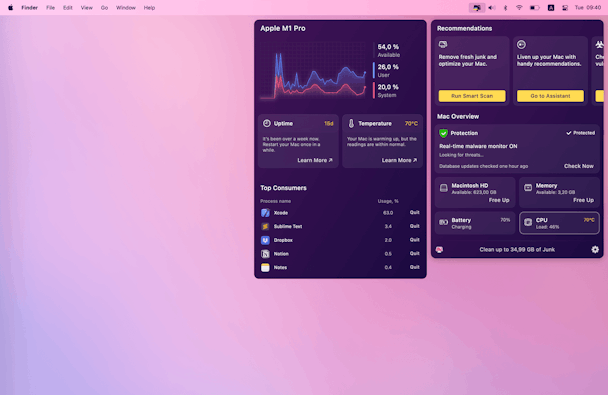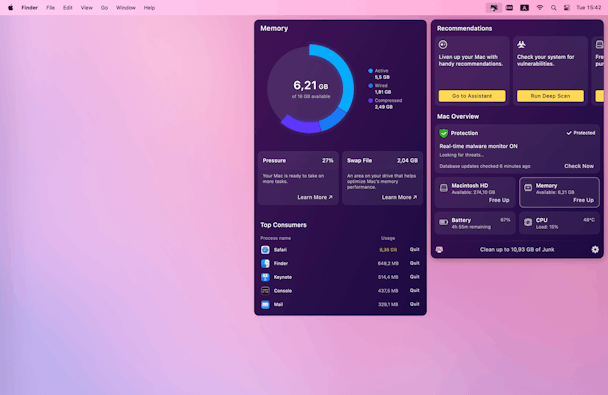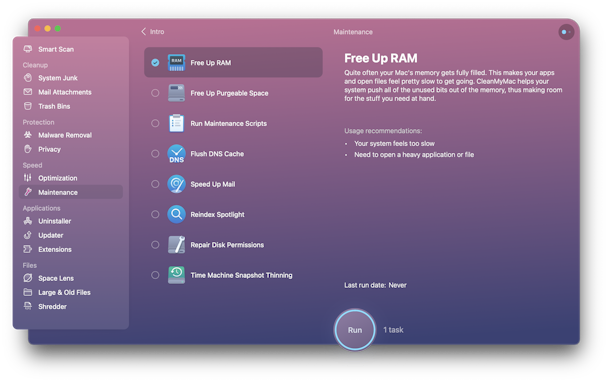Macbookpro Continues to Have Spinning Beach Ball
The rainbow-colored circle is a painful sight to see for Mac users. If you're lucky, it disappears in a few seconds, but more often, it remains for minutes, leaving you helplessly locked out of the app or your whole Mac. Since it's not always clear how to deal with the wheeling cursor or what caused it in the first place, let's break it all down. In this article, we'll take a look at what is the spinning beach ball, why and when it shows up, and what you can do about it.

What is a spinning color wheel?
Initially, it's a system indicator. Its official name is the Spinning Wait Cursor, not so official — the Spinning Beach Ball of Death or SBBOD. The ball signifies that your Mac cannot handle all the tasks given to it at this moment.
Every app on your Mac has a so-called window server. When an app receives more events than it can process, the window server automatically shows you the spinning ball. It usually takes about 4 seconds for the app to decide that it's non-responsive.
Why does the Mac spinning wheel of death appear?
Well, the reasons are countless. First, it can be a stand-alone issue with a certain app. Second, it could be faulty hardware or insufficient RAM. We'll go over each possible issue and see how it can be fixed, depending on the cause. Sometimes, the only way out is getting a new Mac, but most of the cases can be fixed with the right software or system commands.
How to stop the spinning ball on Mac?
In case you just need to unlock one frozen application, that's a job for Force Quit.
To fix an application stuck with a spinning cursor right now:
- Click the Apple icon in the top left corner.
- Choose Force Quit (or press Command-Alt-Esc).
- Select the app that won't respond.
- Click Force Quit.

Simply shutting down the process is a brutal way of problem-solving and it doesn't address the issue that caused the freezing. It could have been an accidental glitch in the program, but if it keeps freezing or spreads further to other software and services, you need to look deeper.
What if the application keeps freezing when you open it again?
Reset or reinstall the freezing application. Macs don't have a proper uninstaller, and moving applications to the Trash bin leaves plenty of app leftovers. Some of them could be the reason why the spinning wheel showed up, so if you leave them, the issue will stay.
How to reset a Mac app to its default settings or uninstall it
There are two ways to reset apps: one would be to use the application's own preferences or settings and look for reset options there. But in case the app won't let you do that (because it keeps freezing), you can turn to third-party solutions, like CleanMyMac X for instance. It's a handy app for Mac maintenance and cleaning with plenty of useful tools, including reset and uninstallation.
- Download the free version of CleanMyMac X, an app for Mac maintenance.
- Open it and click on the Uninstaller.
- Select the app you need to reset from the list.
- Click on the small arrow next to the application icon
- Click Applications Reset.

If the beach ball keeps rolling when you use the app again, reinstall it completely by pressing Uninstall instead of Reset. Remember, simply moving the app to the Trash doesn't do the trick since its leftover files remain on your hard drive.
Important: if you have a license for the paid app, make sure to save the number somewhere.
What if your whole Mac becomes unresponsive?
Possible issue: Overworked processor
One of the reasons for the wheel to show up could be that your Mac is getting old. You can figure out if that's the case by checking the CPU usage. To check the CPU usage, turn to the Activity monitor. Find it in the Applications/Utilities folder or run a Spotlight search.

The bottom table shows System load in percentage. If it's way above 50% and remains there for long, especially without any specific reason like games or heavy rendering programs, this might be the signal your processor is the bottleneck.
Fix:Get in the habit of closing apps when they are not in use. Also, choose Safari over Chrome.
There is a free tool you can use to check the actual toll on your Mac's CPU. The before mentioned CleanMyMac X offers this little Menu in a free version of their app. It analyzes the CPU temperature and app pressure.
- Install the app.
- Click on the small iMac icon in the upper menu bar.
- Find the CPU tab.

See the list of apps at the bottom? These are the ones that eat up a lot of processing power. You can always quit a few.
Possible issue: Low disk space
You don't even need to have a full startup disk to see the nasty ball. Just a heavily loaded hard drive with lots of large files can already cause trouble with loading.
Fix: Hard drive cleanup. Thankfully, that's an easy task. You can get CleanMyMac X and free up tons of space in a few minutes. With CleanMyMac you don't need to dig into folders and look for files you don't need, the app will find and sort them, plus all the system junk your Mac has been accumulating for months.
Possible issue: Insufficient RAM
Another possible hardware issue is insufficient Random Access Memory. To figure out if you need more RAM, open the Activity Monitor again. It's in the Applications/Utilities folder. In the Memory tab, you can see a Memory pressure table with a graph. If the graph is red and your memory is constantly strained under all the running apps, you've found the problem.

Note when your Memory Pressure graph begins to turn red.
Fix: You can upgrade RAM by buying and installing more of it. It's usually enough to have 8 GB for most tasks and applications, apart from heavy video rendering and the likes. Here's a detailed guide on how to upgrade RAM on Mac.
Memory pressure is a reliable indicator of your Mac's speed. To better understand how the memory is utilized, you can once again look at the free Mac health analyzer, a.k.a. CleanMyMac X's Menu. It's available if you click on the little iMac icon in the upper menu bar on your Mac.

Tip: A quick memory fix using CleanMyMac
In CleanMyMac X, the app we mentioned above, there is a tool to quickly free up RAM when you need it. It acts like a "knife-switch" and releases RAM resources when you need to unfreeze an app.
Download the free version of CleanMyMac X — this program is notarized by Apple.
Open the Maintenance tool and click Free up RAM.
This is a temporary solution but check out the other helpful Mac optimizations in this app.

That's about it concerning the spinning beach ball and how to deal with it. We hope this guide has been of help, and you'll stop the spinning wheel of death on your Mac once and for all.
schardtaceeakell1955.blogspot.com
Source: https://macpaw.com/how-to/the-spinning-wheel-on-mac
0 Response to "Macbookpro Continues to Have Spinning Beach Ball"
Post a Comment